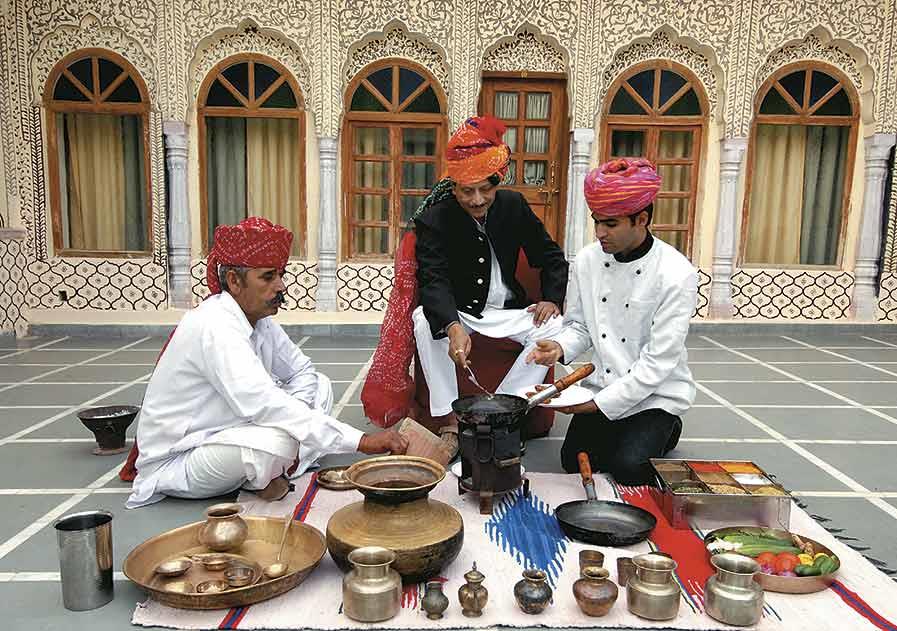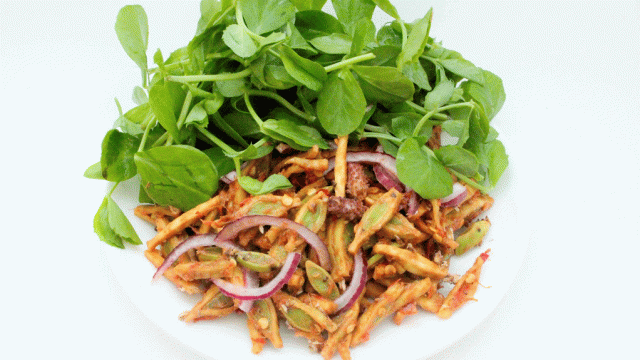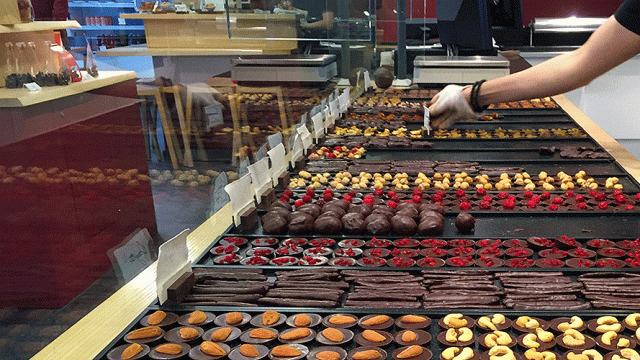On the dusty road to Surajgarh, the tiny village from where one begins the journey into Rajasthan’s

Royal kitchens were the forerunners of today’s luxury restaurants and banquet halls, except that they had superior menus. If the pleasure-loving Kaiqabad could serve a thousand dishes at a feast in honour of his father, Maistre Chiquart would set down the basics necessary for a feast preparation two centuries later in France: one hundred well-fattened cattle, one hundred and thirty sheep, one hundred and twenty pigs; and for each day during the feast, one hundred piglets, both for roasting and for other dishes, and sixty salted large well-fattened pigs for larding and making soups. After this, suggested Chiquart, a good chef would turn his attention to kids, lambs, calves and “two thousand head of poultry”, an equal variety of fish and “for each day of the said feast, six thousand eggs”.
And in China, the beautiful but gluttonous Lady Dai would have ample provisions buried with her so that she would never be hungry in death: pheasant bones, ox ribs, wheaten food, lotus root strips, cakes of sticky rice and ample wine and broth were found in her grave.
But Surajgarh’s local population of cows, camels and goats seems to be safe enough. We’ve arrived mid-week, and while the hotel has anywhere from 40 to 80-odd guests dropping by for the Sailana Food Festival on the weekends, it’s fairly quiet at other times. The most raucous inhabitants at the hotel are a beautiful flock of Alexandrine parrots, who will spend the next two days supervising the cooking arrangements, like medieval courtiers offering up their ‘wah-wahs’.

It takes me a while to register that the soft-voiced gentleman who asks anxiously whether our journey was comfortable and whether we’d like a little nimbu-pani is the Maharaja of Sailana himself. HRH has a tendency to wince if you call him by any of his royal titles, and has an absent-minded air that reminds you of Lord Emsworth of Blandings, but he sparkles on the subject of food.
The Sailana kingdom’s fascination with good food stretches back for three generations. HH Vikram Singhji’s grandfather, HH Sir Dilip Singhji, learned to cook late in life. “The royal family had gone travelling, and there was some sort of a muddle—the cooks got left behind on the road, so when they arrived at their destination, my grandfather discovered that not a single person in their entourage knew even the basics of cooking,” says Vikram Singhji. Sir Dilip Singhji was in his fifties then, but from that week, he taught himself how to cook — maharaja-style, as Vikram Singhji will demonstrate for us in the afternoon.
If you’re a maharaja, you cook in much the fashion of a top professional chef. The actual preparation is carried out by the kitchen staff; a suitable balcony or verandah is located, and sigris, rugs, vessels, spices and key ingredients are brought out in procession while HH waits in royal splendour. He makes two relatively simple — but extraordinarily tasty — kababs for us, seated in the open-air courtyard at the top of Surajgarh fort while Naren, the head chef, watches and takes notes. The Goolar Kabab is made to resemble the shape of the local figs; a fish tikka is wonderfully light, with a crisp coating. These, it turns out, are just a taste of what we can expect.

As he makes arrangements for what seems to be a formidably elaborate dinner, Vikram Singhji discusses Sailana’s legendary hospitality. His grandfather was famous for his banquets, which featured such amuse-gueules as puris of a certain thickness, cooked very rapidly: when the guest of honour punctured the top of a puri, a live sparrow would fly out. Sailana sat at the crossroads of Madhya Pradesh and Rajasthan, and Sir Dilip Singhji developed a fascination with the cuisine of other royal houses. The best-known legend about Sailana revolves around Sir Dilip Singhji’s spice box and jewellers’ scales. Knowing that the chefs who travelled with their royal patrons would never reveal the exact proportion and number of spices used in a particular dish, Sir Dilip Singhji would present them with his spice box and tactfully retreat from the kitchen. The chefs would finish their cooking, confident that they had revealed no secrets; but when the spice box went back, its contents were weighed on the jewellers’ scales, and Sir Dilip Singhji had, by subtraction, the exact ingredients of the dish.
“I remember my father cooking in the evenings, on the verandah,” says Vikram Singhji as he inspects the jackfruit (“cut too thin, it won’t absorb enough gravy”) and checks on the marinade for the raan. Sir Digvijaya Singh, his father, inherited the family fascination with fine cuisine and compiled a cookbook — Cooking Delights of the Maharajas — where he has pleaded with today’s cooks and chefs to try the old recipes without taking short cuts.
Some of what we’re served for dinner sounds like the standard fare you’d find at any good North Indian restaurant, but here’s the thing: food cooked by the hands of a maharaja really does taste different. Perhaps it’s the obsession, carried out over three generations, with locating just the right version of the classic recipes, but the raan musallam is outstanding, more delicate and more intensely flavoured than anything I’ve come across in the great kitchens of India. There are little surprises: a classic lauki ki halwa, which transforms the humble bottle gourd into a dish you could serve at, well, a maharaja’s table; though he doesn’t serve the famous gulab jamuns made of mincemeat, or the meat cooked in sandalwood essence, scented by its very special aroma.
We’ll see more of this playfulness over the next two days. An unusual mutton dahi bada brings a richness to this usually vegetarian dish; a gulab ki kheer, made with fresh rose petals, is astoundingly fresh on the palate; and Vikram Singhji’s nargisi koftas are soft and tender, melting on the tongue. Between Sailana and Surajgarh, the two royal households are also trying to revive the art of making the old liqueurs — Vikram Singhji spends a day fussing over the cardamom and the rose liqueurs, adding more essence and fresh spices. It’s lost on a non-drinker like me, but the two ladies from England assure me it has the kick and the freshness of Benedictine. And all the while, the maharaja fusses over the presentation of his dishes and the service, adjuring the photographer to eat before the meal gets disastrously cold, explaining why one must eat each dish separately: “Biryani should only be mixed with raita, eat the jackfruit before the murg musallam, or its flavours will overpower the vegetable.”
He is slightly wistful that he can’t offer us any game. “Soovar ki santh — a dish made of the fat of a freshly killed wild boar — is good for arthritic pains and rheumatism,” says Vikram Singhji. He thinks about it: “It also tastes incredible.” Like many scions of royal houses, he is passionate about defending a certain kind of responsible shikar, where the royal hunt was a benevolent and necessary culling rather than a soulless bloodbath. But he laid down his gun many years ago after a bizarre incident.
“We were shooting fish — the really large ones you find only in certain streams. And I saw this huge fish leaping down the stream as though it had gone completely mad, its tail lashing out left and right,” he says. “I sighted the fish, and shot it. When we went down to the stream, we saw that it was a female… and that about 200 of its babies were lying dead on the surface of the stream, killed by the blast from the gun. I felt terrible; she hadn’t been mad, she had just been trying to protect her children. I’ve never shot since that day.”

As we settle down to yet another incredible meal, I’m glad that HH hung up his guns, but not his knives and cooking spoons. The Sailana Royal Food Festival has turned out to be an unexpected surprise — small and intimate, but offering the promise of truly rare dishes cooked by a passionate chef who happens to be a maharaja as well. There are no gimmicks served alongside HH of Sailana’s feasts: just excellent food and recipes you won’t get anywhere else.
The food festival is supposed to be an annual affair, but if you find yourself in Surajgarh when HH is not in residence, just ask Naren to hold the butter chicken and serve up some of the old Sailana classics instead. Yes, you’ll gain several kilos if you eat like a maharaja, and yes, it’ll need more than a light session of Pilates to work this off — but as I return, groaning and replete, back to Delhi, I know it’s been worth every extra inch.
The information
Getting there: About 180 km from Delhi, Surajgarh is 3hrs and 30min away by road.
Where to stay: The Surajgarh Fort (from Rs 2,400; 011-25889516, 25885709,www.surajgarh.com) is an 18th-century fortified palace. It was restored and the hotel is managed by Tikaraj Aishwarya Katoch and Tikarani Shailija.
What to see & do: Surajgarh is the portal of Rajasthan’s celebrated Shekhawati region. There are several painted havelis in the area that are wonderful to tour on foot or by camel cart.
Recipe: Mutton Dahi Bada
Preparation time: 30min; cooking time: 1hr, 30min; to serve: 10 persons
1/2kg minced lean mutton (keema) from leg or shoulder
12gm salt
12gm red chillies (powdered)
12gm coriander seeds (powdered)
3gm turmeric
3gm cumin seeds, whole
100gm onions, ground
12gm garlic, ground
12gm ginger, scraped and ground
60gm split gram (chana dal)
6gm garam masala powder
750gm curd, fresh and thick
6gm salt
18gm sugar, powdered
4gm fresh mint leaves, finely chopped
600ml sour buttermilk
Ghee for frying badas
Boil meat in about 4 cups of water along with salt, red chillies, coriander, turmeric, cumin seeds, onions, garlic, ginger and split grams. When tender, dry the liquids completely. Add garam masala powder. Grind the meat finely.
Divide into 20 equal parts (into round badas). Flatten, wetting hands with a little water to give the badas a smooth and even shape.
Heat ghee in a frying pan and shallow fry the badas, till dark brown in colour. Immediately put them in buttermilk. When they sink to the bottom, take them out and with both hands squeeze each of them gently to remove the superfluous fat and water, taking care not to break them. Place them in a serving dish.
Sieve curd through muslin and mix into it salt, sugar and the mint leaves. Pour curd on the badas and let them stand for about an hour. Serve cold.
Not to be put in the refrigerator as the badas lose their softness.
From Cooking Delights of the Maharajas, by HH Digvijaya Singh
Nilanjana S Roy
Rajasthan
Rajasthani cuisine





